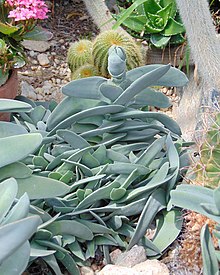Our website is made possible by displaying online advertisements to our visitors.
Please consider supporting us by disabling your ad blocker.
Crassulaceae
| Crassulaceae | |
|---|---|

| |
| Crassula perfoliata Type species | |
| Scientific classification | |
| Kingdom: | Plantae |
| Clade: | Tracheophytes |
| Clade: | Angiosperms |
| Clade: | Eudicots |
| Order: | Saxifragales |
| Family: | Crassulaceae J.St.-Hil.[1] |
| Type genus | |
| Crassula | |
| Subfamilies | |
| |
| Synonyms | |
|
Sempervivae [Sempervivaceae] Jussieu[2] | |
The Crassulaceae (/ˈkræsjuːleɪsiːˌiː, -siˌaɪ/, from Latin crassus, thick), also known as the crassulas, the stonecrops or the orpine family, are a diverse family of dicotyledon angiosperms primarily characterized by succulent leaves and a form of photosynthesis known as crassulacean acid metabolism (CAM), in which plants photosynthesize in the daytime and exchange gases during the cooler temperatures of the night. The blossoms of crassulas generally have five floral parts. Crassulaceae are usually herbaceous, though there are some subshrubs, and relatively few trees or aquatic plants.
The Crassulaceae is a medium-sized, monophyletic family in the core eudicots clade, along with the order Saxifragales, whose diversity has made infrafamilial classification very difficult. The family includes approximately 1,400 species and 34–35 genera—depending on the circumscription of the genus Sedum—distributed over three subfamilies. Members of the Crassulaceae are found worldwide, though are mostly concentrated in the Northern Hemisphere and Southern Africa (where the most species are found). They are adapted to thrive in typically dry, arid (hot or cold) areas where water may be scarce, and richer, organic substrates may be at a minimum or nonexistent. The Sempervivum (houseleeks) of Central and Southern Europe, or the Orostachys (dunce-caps) of Asia, for example, grow in rocky crevices at higher elevations, where soil is at a minimum but precipitation, sun exposure, and winds may be intense; these plants have thus adapted to absorb water by having succulent leaves, despite living often on slopes or near-vertical cliff faces, from which water typically drains quickly. Their roots are adhesive and grip to any rock, dirt, wood or other surface they come into contact with, while also gleaning minerals from said material. Seedlings that may sprout near more permanent sources of water, such as pooling rainwater or seeps, may experience rot or discoloration over time, and not survive.
Crassulaceae are mainly perennial, and have huge global economic importance as collectible specimens, and as indoor and outdoor garden plants. Many species in the family, especially of the African genera, have highly unusual (for plants) and otherworldly appearances, often with interesting textures (fuzzy, hairy, spiky, scaly) or curious nodules or growths, all of which are typically the result of environmental adaptations, such as "fuzzy" Kalanchoe tomentosa utilizing its hairs as a sunscreen. Apart from some sensitive species, most are quite hardy, typically needing only minimal care. For every alien-looking species, there are just as many others with a more "conventional", rosette growth habit, something reflected in many common names, such as 'Black Rose', another name for the common Aeonium arboreum var. 'Swartzkopf'.
Well-known genera and species include the many forms of Crassula ovata ('Jade', 'Money Plant' or 'Friendship Tree'), Kalanchoe blossfeldiana (florists' or supermarket-kalanchoe); Cotyledon, such as 'Chalk Fingers' and 'Pig's Ear', Sempervivum such as cobweb houseleek (or hen-and-chicks) and S. calcareum, and Aeonium such as A. haworthii (and its popular variegate 'Kiwi'), A. arboreum, canariense, urbicum; Monanthes, Umbilicus (pennywort), Bryophyllum, Echeveria, Sedum and Dudleya.
Previous Page Next Page


